Intel X58 Motherboard Roundup - What does $300 Get You?
by Gary Key on December 5, 2008 3:00 PM EST- Posted in
- Motherboards
SATA Performance
PCMark Vantage is the latest benchmark available from Futuremark, and it is only for use with Windows Vista. Similar to the venerable PCMark05 in its makeup, Vantage modernizes the criteria and test methodology to reflect what users may encounter when running the new Windows OS and current applications. The total HDD benchmark is roughly 87% reads and 13% writes in nature. We run each test five times per drive, producing a median score that we use for comparison in our charts. We utilize AHCI settings for each board.
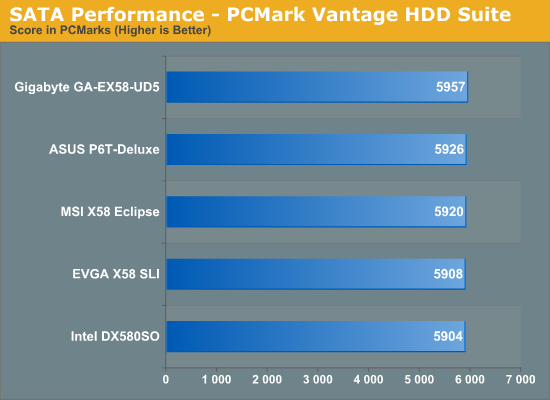

All of the boards utilize the ICH10R for primary storage duties, so there is little difference between the results. In our secondary controller results, we see the SAS solution from Marvell leading the JMicron controllers utilized on the other boards. The MSI and Gigabyte boards both utilize the JMB322 chipset, but we see the MSI board performing better since the JMB322 resides directly on the PCIe bus instead of utilizing the JMB363 as a pass through chip in the same manner that Gigabyte does. EVGA uses the JMB363 chipset and it just barely slides past the Gigabyte setup.
USB / FireWire Performance
Our USB transfer speed tests are conducted with an OCZ Rally 2 Turbo 4GB Flash Drive and USB 2.0/FireWire based Maxtor OneTouch II external hard drive. In the small file test, we transfer a 602MB file folder containing 444 files of various sizes from our hard drive to the USB Flash drive. In the large file test, we transfer a 1.90GB file folder containing 17 different files from our hard drive to the external drive utilizing the USB 2.0 and IEEE 1394a interface.
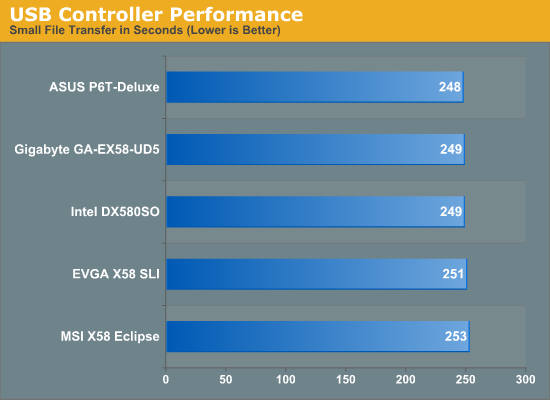
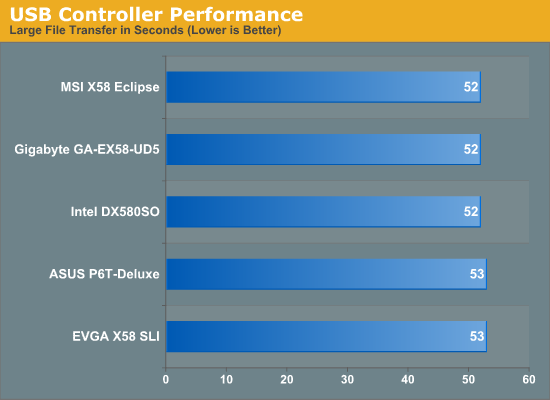
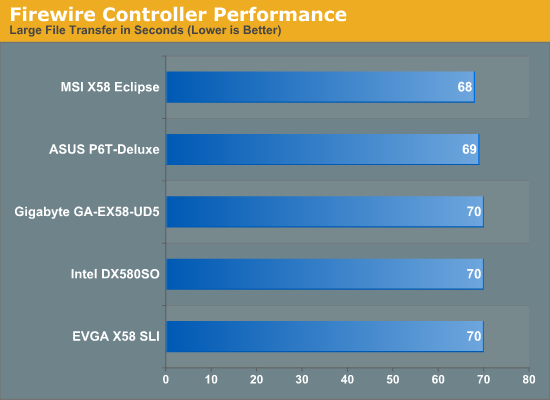
USB performance should be a wash since all the boards use the same ICH10R chipset that provides the USB capabilities. While our synthetic HD Tune tests indicate parity between the boards, the actual transfer of files in the small file test indicates a slight advantage to the ASUS, Gigabyte, and Intel implementations. Our large file USB test is basically a wash as the external hard drive becomes the limiting factor. The VIA FireWire solution on the MSI and ASUS boards hold a small advantage over the Texas Instruments chipset on the other boards.
Networking
The Windows 2000 Driver Development Kit (DDK) includes a useful LAN testing utility called NTttcp. We used the NTttcp tool to test Ethernet throughput and the CPU utilization of the various Ethernet Controllers used on the Intel motherboards. We set up one machine as the server; in this test, an Intel system with an Intel CSA Gigabit LAN connection. Intel CSA has a reputation for providing fast throughput and is a logical choice for our Gigabit LAN server.
On the server side, we used the following Command Line as suggested by the VIA whitepaper on LAN testing:
Ntttcpr -m 4,0,‹server IP› -a 4 -l 256000 -n 30000
On the client side (the motherboard under test), we used the following Command Line:
Ntttcps -m 4,0,‹client IP› -a 4 -l 256000 -n 30000
At the conclusion of the test, we captured the throughput and CPU utilization figures from the client screen.
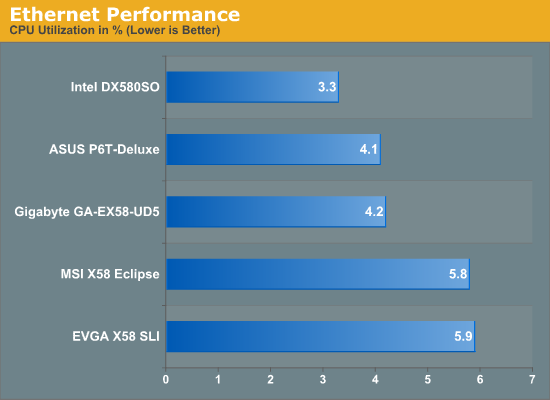
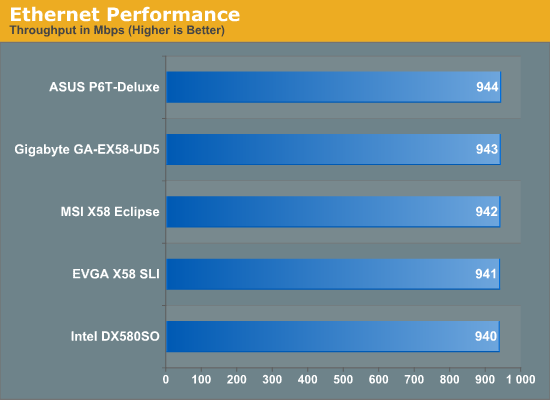
Our network throughput test indicates how well a particular controller design from Realtek, Marvell, or Intel performs instead of being indicative of true chipset performance. This also holds true for the CPU utilization results, though this test can also be influenced to certain degree by the BIOS code and chipset interconnect design.
The CPU utilization numbers favor the integrated GbE controller on the Intel board, followed closely by the Marvell chipset on the ASUS board. The EVGA, MSI, and Gigabyte boards use similar Realtek networking chips, but the Gigabyte board uses the newer RTL8111D over the MSI/EVGA RTL8111Cs. All of the boards feature excellent throughput, with the Marvell solution edging slightly ahead of the Realtek and Intel solutions.










78 Comments
View All Comments
mvrx - Wednesday, December 10, 2008 - link
I know these motherboards are months away, but please include dual socket i7 reviews as soon as they become available for testing. My next system will be a dual i7 quad for sure and I'm anxiously awaiting these MB's to come out and mature.I didn't go with current dual socket architectures because of FB-DIMMs limiting the performance and costing so much more. Really hoping to see a resurgance of the dual+ socket enthusiast systems.
And if anyone replies "What can you be using that even takes up a single socket quad core" - well.. then you probably don't know enough about enthusiast computing to reply here. ;-)
strikeback03 - Wednesday, December 10, 2008 - link
I'd think that last line shows why we are unlikely to see a resurgence of multi-socket enthusiast systems. There are very few that have applications which would take advantage of more than 4 physical cores/8 logical cores.mvrx - Thursday, December 11, 2008 - link
Well, I approach it with this logic..... and I get this alot from people.. "few applications that take advantage of more than 4 cores". I'm not running one or two applications....
MS OneCare (or your chosen security suite), seems to zap 15%-20% of overall system performance depending on what it's doing.
Even my old LOTR BFME2 ROTWK game spans 4 cores.. Not very well, but it does.
I run a skype conference server for gamers (an upcoming competitor to Ventrilo) with 20 or so callers on the line at once. Skype (especially skype 4.0) spans many cores reasonably well. (s4pg.us - website's not up yet)
I like to leave my email, web browsers, etc - open when I play my games.. and unfortunately I probably have another 10 active programs sitting in the background in some way. According to resource manager I have about 1100 active threads running, I think the average enthusiast only would have 500-700.
Now, I may be the upper-end of the catagory of heavy resource users, but thats mostly because people don't have the horsepower to do more so they don't. Chicken and Egg issue. If I can get a i7 for $300, and maybe the dual socket MB costs me a $150 premium, I'm sure as heck going to go dual socket.
I know one of my biggest issues is HD performance, but I hope to fix that with one of Micron Tech's new PCIe SSD cards... At that point, I'll probably be easily slamming two i7's. And I do like to run x264 mp4 compression jobs overnight. Even if it only liked using 4 cores, I can run several instances at once.
According to the roadmaps, the X58 is dual socket ready.. So I doubt it will be long until we see at least a few boards.
anindrew - Wednesday, December 10, 2008 - link
I had already ordered and received most of my parts for my new X58/i7 920 based system before this article went up. I was anxiously waiting for it to see what Anand and crew thought. Like so many commented here, I had no idea Anandtech's crew helped sort out issues with motherboards and BIOSes. I think it would be interesting to hear more about that and specifically why you did that (by choice or to help everyone).I built my system yesterday using the Gigabyte GA-EX58-UD5, i7 920, and 6GB of G.Skill DDR3-1600 8-8-8-21 memory (those are the actual specs of it). I have had no problems at all setting the system up. Everything works as it should. I have not tried to overclock yet, but I will since I have the Noctua SE1366.
The Asus P6T does look great, and I am happy to hear that it worked as it should right away. I had to debate between the Asus and Gigabyte boards. In the end, I chose the Gigabyte because I got a $30 discount in a combo with the Geforce GTX260 core 216. Time will tell if I made the right choice. :-)
chuckbam - Tuesday, December 9, 2008 - link
I member of ABXZone.com pointed out to me that the ASUS P6T Deluxe has a memory range conflict on the device I/O APIC controller. Does anyone have more information on this?http://chuckbam.com/Posts/IOAPIC.PNG">http://chuckbam.com/Posts/IOAPIC.PNG
chrhon - Tuesday, December 9, 2008 - link
Thank you for bringing up those comments at the begging of the article. Pretty much everyone I talk to is fed up with motherboard problems and even considering something such as buying from Dell. These mobo manufacturers are shooting themselves in the foot. Sadly the reviews seem to help them.My last build I started with a Gigabyte board and it was good to me but there were complaints on all the reviews on the memory overclocking. Then that board stopped working for me and I bought a DFI board that was universally praised by the reviews and it was the biggest pain in the ass - almost every time I would add or remove a card or flash the BIOS I would go through non-POST hell. I don't see myself EVER buying a DFI board again based on that experience.
If a motherboard company comes out bragging about its quality components and stability THAT is where I am going to put my money. Believe it or not its things like chipset fans being cheap and going out that make more difference in long term satisfaction of a board than one more (when there are already 50) way to tweak some voltages.
Kroneborge - Tuesday, December 9, 2008 - link
Reliability is definitely key. Fast doesn’t matter if your computer won’t run. I do music production, along with my games, and I want a system that is going to run all the time with no problems. If that means I can’t overclock, then I would rather do that. I definitely suggest adding a reliability chart so those of us who need computers for production purposes can factor that in.Also for music production having 12gb or even 24 is perfectly reasonable for large sample libraries. Manufacturers that think supporting those sizes (as advertised) isn’t a priority are wrong.
Thanks for the great review, and please continue to put an emphasis on things working. And keep updating stuff so we know where they stand. I for one won’t be purchasing my new computer till I’m sure I can get it working with little fuss right out of the box.
SiliconDoc - Tuesday, December 9, 2008 - link
That was very kind of you Anand - to point out how the monster that was created is out of control...rofl - I couldn't help thinking - imagining - it's just like the bankers/loan officers/fannie n freddie freaks that fried the economy with wild eyed speculation and housing bubbling... just crazed wackos doing "what must be done" in the name of ... well profits or chest thumping or bonuses or bragging rights or all the above in all cases...
Now the crash and burn of simple motherboard features not even working is splaying out in the public - I've seen the posted reports by the end users...
"We don't have to do it right - or even ethically *advertised features actually work* - seems to be the call of the day everywhere.
So anyway - good job actually EXPERIENCING THE LAST STRAW AND TRYING TO DO SOMETHING ABOUT IT .
Hopefully the pendulum will swing back toward center without anyone getting fragged... (although I'm sure purchasers in some cases wish otherwise).
SiliconDoc - Tuesday, December 9, 2008 - link
PS - Yes, so that I'm not missing something either - it DOES sound like they owe Anand and the staff about a million bucks (each).I can see how a good review here and there has now ballooned into "lab support" ....
A million bucks each ought to do - the manufacturers can take up an R&D collective - if they threaten to cut off boards just do a maniacal laugh - they will crumble and pay up.
;-)
araczynski - Monday, December 8, 2008 - link
mildly interesting, but personally i'd like to see this in comparison to something from the 'normal' lineup, you know, like what most people currently have.throw a C2D/3ghz/4gb in there and then we have something interesting.
compare apples to apples, not just apples to themselves.